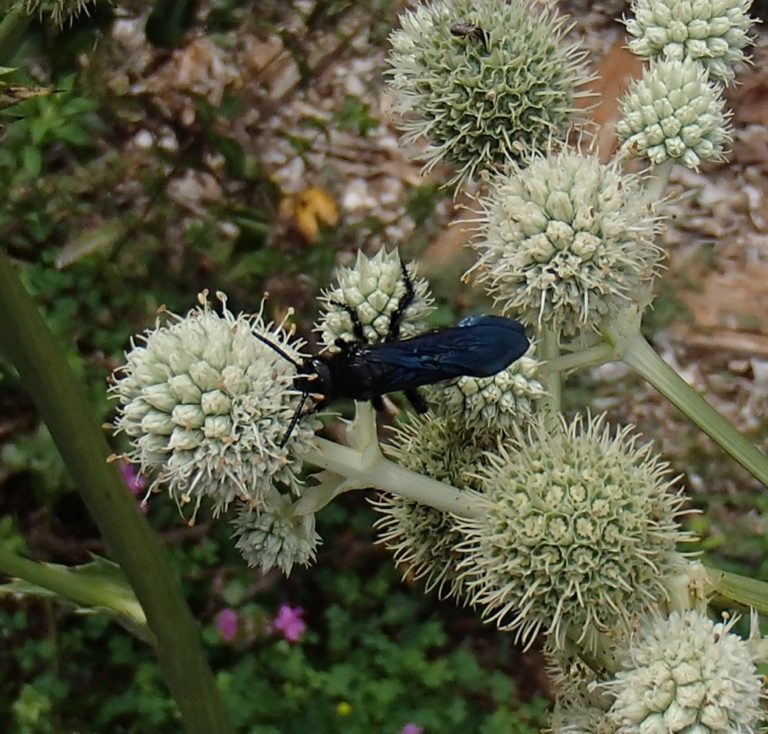Rattlesnake Master is a forb characteristic of the tall grass prairie but it is native to the eastern portion of the U.S. south of West Virginia. It has unusual form — some say architectural — as well as color (greyish green throughout), reminding one of a desert plant. Rattlesnake Master has a heavy crown and tap root, which provide drought-hardiness but which make it difficult to transplant. It is best grown in full sun with well drained soil in a range of pH, like the warm season grasses which are so visually complementary and which can help it remain upright. The dominant leaves, long and strap-like, appear as a basal rosette and are up to 2 ½ feet long, 2 ½ inches across, (“yuccifolium” = leaves like a Yucca plant). This foliage supports one or two 3-5-foot, branched flowering stalks each with 4-5 “button” inflorescences. The stalks and inflorescences are similarly greyish greenish white and fragrant. The button-like inflorescence contains many white, stalkless flowers subtended by spiky, prickly bracts, and the flower head resembles a thistle. It is pollinated by many insects, especially wasps, and it is valuable for supporting insect diversity.
NURSERY HOURS
Wednesday: 10-4 Thursday: 10-6 Friday-Saturday: 10-4 Sunday: 12-4
Eryngium yuccifolium

Key Info
Scientific Name: Eryngium yuccifolium Michx.
Common Names: Rattlesnake Master, Button Eryngo, Button Snake-root, Yucca-leaf Eryngo, Corn Snakeroot, Water-eryngo, Rattlesnake Flag, and Rattlesnake Weed.
Family Names: Apiaceae (Carrot Family)
Plant Type: Herbaceous perennial
Light Requirement: Full sun
Flower Color: White
Special Characteristics: Interesting form, Reported to be deer resistant., Good in dried arrangements, Tolerates drought
Additional Info
Habit: A sturdy, short tap root and hefty crown give rise to a basal rosette of sword-shaped, leathery leaves which in turn supports one or two branched, erect flowering stalks. The rosette forms offsets which can be divided, and this plant also self-seeds in favorable conditions.
Height: 4'-5'
Spread: 2-3'
Soil Conditions: Average to dry, well drained soils, acid or alkaline, sandy, loamy, rocky, clay.
Leaves: The basal rosette leaves resemble those of the Yucca plant. They are leathery, sword-shaped (to 3 feet long), medium green, with bristly margins and, although this plant is a dicot, they posess parallel venation. There are smaller stem leaves as well, which become shorter towards the top of the shoot. All the leaf bases clasp the erect stems.
Flowers (or reproductive structures: Globular, 1 inch-diameter flower heads resembling thistles appear in branched clusters at the top of smooth, stiff, greyish green stems 4-5 feet high, arising from the center of the rosette. The flower heads are composed of many small, stalkless, greenish-white florets. Flower heads are subtended by small spiny, whitish bracts at the base. The blooms are often strongly fragrant and are pollinator magnets.
Fruit: The flowers each produce two fruits (schizocarps), which have serrate wings for dispersal.
Natural Distribution: Moist to slightly dry black soil prairies, clay prairies, sand prairies, thickets, typical savannas, sandy savannas, and limestone glades (Illinoiswildflowers.info).
USDA Hardiness Zone: 3 to 8
USDA Wetland Indicator Status in NC: FAC
Pollination: Major pollinators include a diversity of bees, wasps, and flies.
Wildlife Connections: Button eryngo is a host plant for Swallowtail butterfly larvae and a nectar source for many pollinators. Monarch butterflies, skippers, and other butterflies visit the flower heads for nectar. Soldier beetles visit the flowers to eat pollen. This species contributes greatly to insect diversity. (USDA Forest Service) but the prickly flower heads are not popular with mammalian herbivores. Voles and other rodents often feed on the plant’s crowns during the winter.
Propagation: By division of offsets or by seed.
